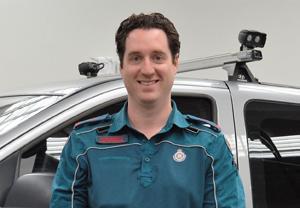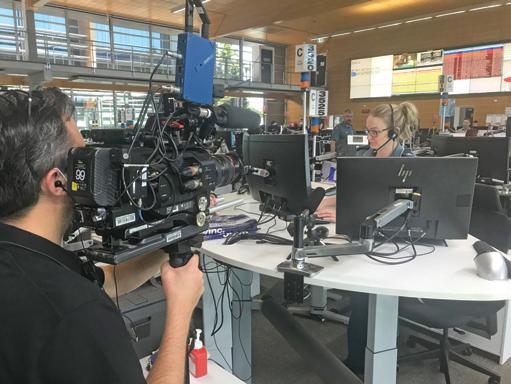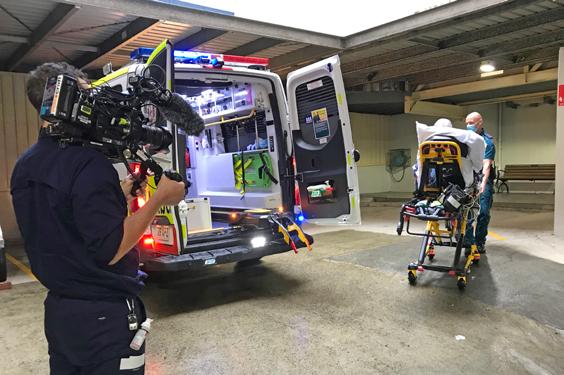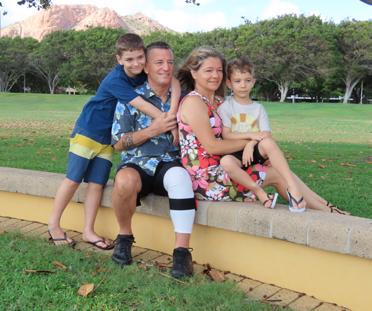
9 minute read
LARU Report
Welfare check on the ‘well’ septic patient
LARU officer David Krygger reports on a code 2C case involving a welfare check on an elderly patient living in public housing who was not answering phone calls from her family.
Advertisement
Above
LARU officer David Krygger is based at
Mermaid Waters Ambulance Station on the
Gold Coast.
I was met at the front door by Dorothy, an 89-year-old female who was surprised to see me.
I explained to Dorothy that we had been called because her family had been worried about her this morning when she had not answered her phone. Dorothy seemed surprised that she had not heard the phone but stated that she had forgotten to put her hearing aids in today and was very apologetic.
Dorothy presented calm and was engaging reasonably well in the conversation, she was independently mobile and even offered to make me a cup of tea, which I politely refused. She had no pain or discomfort, admitted that her sleeping hadn’t been the best recently, but that this was normal for her in recent years. On face value, her presentation seemed normal for an elderly person living at home alone–with a reasonable excuse for not hearing the phone calls from her family.
I asked if I could see her medications, to which she pulled out a large plastic box filled with multiple boxes of tablets. I found anti-hypertensives, statins, a beta-blocker, aspirin, methotrexate, Panadol osteo and Ural sachets. She told me that she had high blood pressure, high cholesterol levels and rheumatoid arthritis. Many of the boxes were empty, and some had old prescription dates on them. Notably, I found a box of trimethoprim with most of the tablets still in the sleeve and a prescription date from five days ago. I asked Dorothy about this prescription and she was unable to remember why she needed that. This prompted me to ask about any urinary symptoms recently and whether I could conduct an abdominal examination. She answered that she had been feeling well recently, with no urinary or other symptoms. Her abdominal examination was N.A.D.
When doing her vital-signs I found the following:
• BP–110/80 • HR–70bpm–Sinus Rhythm on 4-lead
ECG • RR–24 • Temp–37.1 • BSL–5.8 • SpO2–97% on room air • GCS 15–But slow in answering some more complex questions.
I was now concerned about Dorothy due to her recent prescription and non-compliance of an oral antibiotic, her recent acute forgetfulness, immunocompromised status, her mild tachypnoea and likely relative hypotension. My provisional diagnosis was that she likely had an untreated and worsening Urinary Tract Infection (UTI), possibly a urosepsis.
I called her General Practitioner (GP) to seek some further information, to which I found out that she had been prescribed Trimethoprim for a UTI, but had not returned to the GP as requested within two days for a follow up and that she had not been answering her phone. The GP confirmed an E.coli infection post urinalysis. Her GP and I agreed that even though she was presenting well outwardly; she was at risk of rapid deterioration. The recent history of missed phone calls could be a ‘warning shot’ symptom about her deteriorating health.
Dorothy’s outward presentation
• Calm and conversing reasonably well with me • Neat, tidy home • Well dressed, but with heavy clothes on • Not complaining of any symptoms or concerns.
Dorothy’s clinical status
• Likely relative hypotension (110mmHg) in a normally hypertensive elderly patient • Tachypnoea at 24bpm in the setting of a known infection–Is she currently acidotic? • GCS 15, but with some key memory loss.
Dorothy has a high-risk acute medical profile
• Advancing age • Lives alone • Meets SIRS moderate risk clinical features • Q-SOFA score = 1 • Evidence of poor medication compliance • Immunocompromised due to RA treatment • Confirmation from GP of recently diagnosed and unmanaged UTI • Recent abnormal behavioural changes–forgetfulness.
RESULT:
Ultimately, I determined that Dorothy required a hospital admission because she was at high-risk of deterioration. I didn’t feel that referring her back to her GP would eliminate or significantly minimise her risk of deterioration. Dorothy was transported to the Emergency Department via a stretcher ambulance with O2 and IV fluids running where she was admitted as an in-patient for seven days with urosepsis.
FINDINGS:
‘Low acuity’ patients represent our most complex and certainly highest risk patient category. The risk for both the patient and the paramedic can be reduced significantly by taking a thorough history, a detailed assessment and testing a variety of differential diagnoses. Be aware of the patient who appears well; but isn’t.
Officers complete new pilot program
Eight Local-area Assessment and Referral Unit (LARU) officers have successfully completed the new pilot Graduate Certificate in Enhanced Assessment and Critical Reasoning program.
The inaugural officers–Jodie Doyle (Mackay LASN), Kenneth Eyles (Central West LASN), Michael Sams (Darling Downs LASN), Colin Payne (Sunshine Coast LASN), Debra Walters (West Moreton LASN), Jamie Hibbert and Kerrie Fissenden (Metro North LASN) and David Krygger (Gold Coast LASN)–were presented with their certificates by QASEC Director Tim Eva at a ceremony in Kedron’s Emergency Services Headquarters mid-December 2020.
These officers had completed LARU studies previously and were able to upgrade to the Graduate Certificate via a Recognition of Previous Learning and assessment only pathway. The program focuses on enhanced holistic patient assessments including comprehensive medical and social history taking, focused clinical examinations, advanced clinical reasoning, planning and facilitating care pathways, contemporary wound management, and development and maintenance of collaborative partnerships with local and regional health and community services.

Congratulations to the inaugural officers.
Above
■ David Krygger,
Kenneth Eyles, Kerrie
Fissenden, Debra
Walters, Colin Payne,
Michael Sams, Jamie
Hibbert and Jodie
Doyle with their certificates.
www.paramedics.org

@ACParamedicine The Rural Outback and Remote Paramedic Conference is designed specifically for paramedics and allied health professionals working SAVE THE DATE 27-28 May 2021 in rural, outback and remote locations. To allow more members to participate, ROAR21 will be held concurrently in multiple locations, including:
Broome Dubbo New Zealand Townsville Alice Springs
For tickets and more info:
www.paramedics.org/events



Ambulance Australia Lights, camera, action again
The QAS is proud to be filming another series of award-winning documentary series Ambulance Australia with production company Endemol Shine Australia.
Following the ratings success of the last series, filmed with the QAS in 2019 and first broadcast at the beginning of 2020, filming is again being undertaken with five crews and a single responder in the Metro North and Metro South LASNs. Stations involved this time around include Caboolture, Chermside, Balmoral, Nathan, Wynnum, Logan West, Redland Bay and Woodridge. In addition to this, cameras are also rolling in the Brisbane and Gold Coast Operations Centres from March to May. We look forward to seeing the excellent care provided to our patients by our on-road officers and communications staff highlighted on the small screen once filming wraps and the series is broadcast on Channel Ten.



Rick’s fight for survival following serious shark attack
Tracey Cater reports on an amazing story of survival, and a testimony to the strength and determination of one man and a team of paramedics, medical personnel and well-tuned crew resource management.

Above
■ Rick was all smiles at the reunion.
Photo: Lachie Millard, The Courier Mail. Right
■ Rick gives paramedic Alyah Ehierth a big hug.
Photo: Lachie Millard, The Courier Mail. Opposite, left
■ Emergency crews working together to help save the life of Rick.
Photo: Cameron Bates, The Courier Mail. Opposite, top right and bottom
■ Rick shows paramedic Alicia Locke his leg injuries.
Opposite, bottom right
■ Rick with wife Angela and their two boys Troy and Dereck.




On 25 October 2020, good mates Rick Bettua and Peter Kocica were diving at Britomart Reef off Hinchinbrook Island when Peter saw a large bull shark racing towards Rick. Turning around in time to see it strike out, Rick felt the shark grab around his thigh.
Immediately bleeding profusely, former navy diver Rick was remarkably able to pull himself onto the boat and worked with Peter to improvise a tourniquet using diving equipment. As fate would have it a bigger boat which was nearby had an off-duty doctor on board. Rick was soon transferred to this boat where Doctor Ben Reaves tried to stem the bleeding.
Rick, holding onto thoughts of his wife Angela and their two boys, Troy and Dereck, managed to hang on to life until they almost reached the boat ramp, when he blacked out. At this point Ben began CPR as the boat was pulling into the dock. Waiting on the dock were paramedics, the helicopter rescue crew with Flight Critical Care Paramedic Riyu Yin and Flight Doctor David Humphreys, and a local doctor, all of whom wasted no time in administering blood to Rick immediately at the boat ramp. Each person knew their role as they went into action.
It took around an hour of exceptional teamwork from the flight crew and paramedics to stabilise Rick enough to achieve Return of Spontaneous Circulation and a moment of consciousness in which he was able to say, ‘you’re hurting me’. This was music to the ears of paramedic Alicia Locke who was applying pressure to the wound.
Rick was flown to Townsville Hospital where he remained in a coma for several days and underwent multiple surgeries and skin grafts to save his leg.
Amazingly, this was not Rick’s first serious encounter with a shark.
When Glenn Dickson lost his leg to a shark bite incident in 2015 while diving with his friends in waters off Hinchinbrook Island, Rick was one of those mates and the one who applied the tourniquet saving the life of his fellow diver.
In December 2020, Rick walked unassisted into Townsville Ambulance Station with his family to thank everybody involved in the incident. This included paramedics Alicia, Alyah Ehierth and Richard Brown, RSQ Doctor David Humphreys, pilot Nick Kelly and bystander Bastien Iezzi from the boat that brought Rick to shore.
Doctor Ben Reaves, Critical Care Flight Paramedic Ruiyi Yin, Emergency Medical Dispatcher Jarvis Nolan, hospital staff and boat owner Paul Lambert were also in everyone’s thoughts at the reunion as although they were unable to be there, they played a major role in Rick’s survival. For many who assisted Rick, the last memory they had of him was him being loaded onto the rescue helicopter unconscious and fighting to live, therefore it was a remarkable reunion for both patient and responders. Rick and Angela expressed their gratitude to everyone who played a role, including those not present, as well as the friends, families and the wider public that prayed and sent well wishes during Rick’s recovery. Rick left everyone that helped him with the message, ‘you didn’t just save my life, you gave my two boys a Father’.







